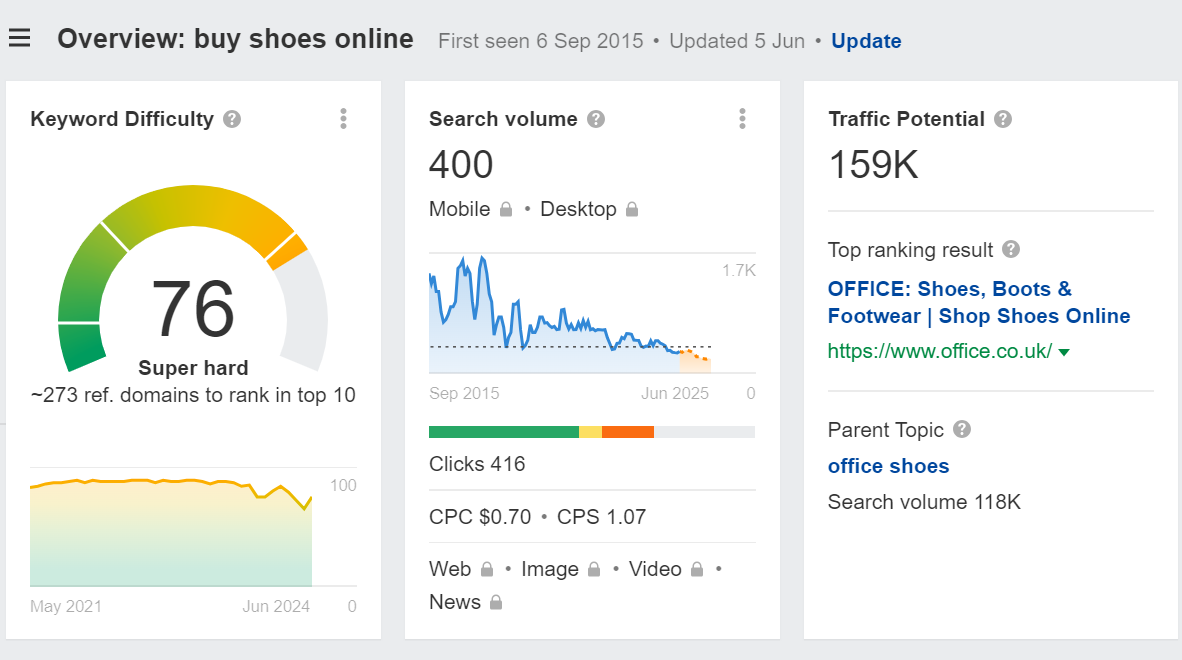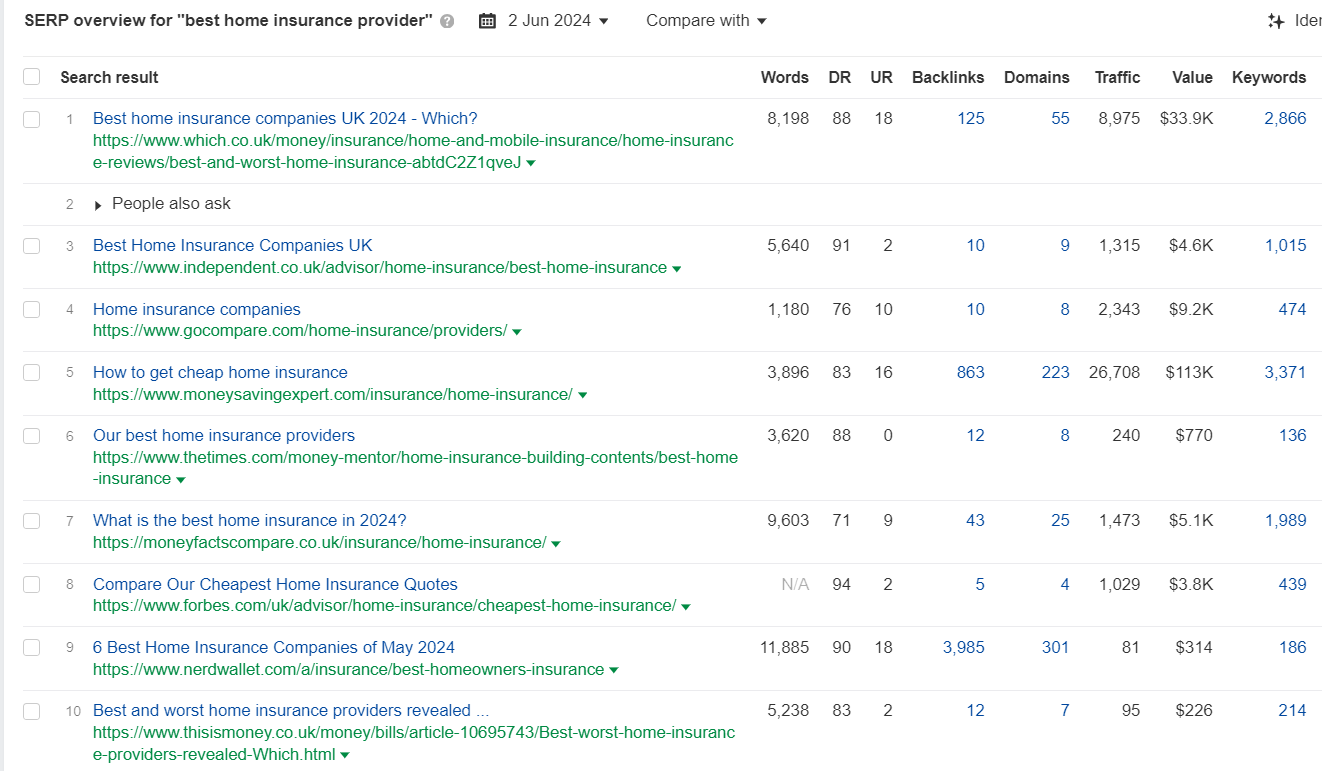SEO Keyword Research Guide: How to Identify the Best Keywords for Quality Traffic
Keyword research is the cornerstone of search engine optimization, the planning step that sets up up for success. The right keyword selection can be the difference in generating quality traffic and great rankings on the one hand, or irrelevant traffic and poor search performance on the other.
Keywords are like a multiplier in a math formula: If it’s a zero, you can do as much optimization and change other variables as you like – The end result remains zero.
A poorly planned, suboptimal keyword selection can make all other websites and SEO optimization meaningless.
Here is a simple 5-step framework helping you avoid any obvious mistakes in keyword selection: to find only those search terms that matter, that you can rank for and generate new business from.
The 5 Factors for SEO Keyword Research
1. Search Volume:
Using keyword research tools like Ahrefs or Semrush, it’s possible to get a clear understanding of how many people search for a certain keyword, based in different countries.
This is not only fascinating to have such transparent insight into market demand and search behavior, but also of foundational importance to your SEO campaign.
Firstly, you need to find keywords that demonstrate there is demand. If there is no interest or extremely little interest, you are likely betting on a “dead horse.”. Writing the most beautiful and carefully crafted content piece is meaningless in SEO campaigns, if nobody is interested in it.
- How to do it: Identify a primary keyword for your page with a volume of more than 30 searches per month, ideally even greater, like 50, 100, or even 500+ searches for this main keyword. This shows there is substance and demand to build on.
Don’t worry if keyword volume appears low, e.g. “30 searches per month”. If it’s highly relevant traffic, these may just be the right 30 users to attract and do business with and they can become valuable customers. Furthermore, SEO is a game that’s not only won by a single keyword on a page.
- Aim to identify at least 5-10 related keywords similar to your primary focus keyword to ensure you tap into even greater demand.
Keyword Research Summary:
- Find 1 primary keyword with decent search volume (Recommended: More than 30 searches per month in your target country).
- Identify 5-10 more secondary keywords to optimize the same page for, e.g. synonyms, related search terms, questions (FAQ).
2. Keyword Difficulty:
While it’s crucial to find SEO keywords with a good amount of search volume, it’s equally important to pick keywords that you can actually rank for.
Every SEO keyword has a certain difficulty, and a different level of competitiveness. Keywords tend to be more competitive when they are targeted by a lot of different website A niche keyword such as “Find local pub in Kingston, Jamaica” is geographically limited, narrowing down the competition drastically.
On the other hand, keywords such as “Buy shoes online” is highly competitive given the high demand for essential items like shoes, the large amount of vendors in this space and the international competition.
Luckily, you don’t have to guess the competitiveness of a keyword. SEO tools like Ahrefs, Semrush or Ubersuggest generate a keyword difficulty (KD) score, typically from 0 (very little competition) to 100 (highly competitive). Aim for lower scores (0-30 KD) to give yourself the best chances to show up high in search results.

(Image source Ahrefs)
The graphic above shows the high competitiveness rating (76/100) for the keyword, also indicating that 273 referring domains (the number of unique websites linking to your web page) are required to reach anywhere close to the top 10 search positions.
Competitiveness is typically measured by the backlink profile of a website (the number and strength of link mentions the website receives and generally how optimized search results are for the keyword in question.
Keyword Difficulty Summary:
- Find keywords that are low in competition (Between 0-30 keyword difficulty score) if you are relatively small website. You can aim for more competitive keywords (30-60) in difficulty when your site has been more established and when you are comfortable to invest in a more longer-term SEO game (e.g. wait for 1-2 years) for the rankings to materialize.
3. Search Intent:
Keyword volume and difficulty are quantitative metrics, they are helpful and necessary to make decisions on which keywords to target. However, these factors don’t reveal the usefulness of the keyword, or the quality of traffic it would generate.
Here’s where search intent comes in.
Search intent explores the intent of the searcher, and the motivation for typing the keyword in a search engine.
Search intent levels
Intent can be categorized as:
1) Purchase intent (Also called transactional intent)
2) Comparison intent
3) Informational intent
4) Navigational intent
Keywords with purchase intent show that the person is close or ready to pay for your product or service. Here are some purchase intent level keywords:
- “London to Paris flights”
- “Buy kettle online.”
- “Buy black socks.”
- “Purchase new iPhone”
- “Find cheap web designer.”
- “Car wash near me.”
- “Financial adviser services”
- “Landing page design agency”
Not all high-intent keywords show an immediate need for a transaction. In B2B marketing, the search keywords are more indirectly worded.
A keyword like “landing page design agency” may not include a transactional search term, however, it is still a high purchase intent keyword as it comes from searchers that specifically want to find a design agency to design their new landing page.
Comparison intent refers to keywords that indicate the searcher is at least interested in doing business but requires more research and comparison.
Keyword in this intent level can include terms like:
- “HubSpot vs ActiveCampaign”
- “Credit card pros and cons”
- “Cheapest car insurance”
- “Best online form builders”
- “Financial advisers benefit”
- “Compare savings interest rates”
Informational intent refers to search terms that show less purchase intent but still show interest in learning more about certain topics. A keyword may look like this:
- “What are soft skills?”
- “What are walnuts good for?”
- “Link building techniques”
- “SEO research tactics”
- “Types of wine”
Finally, navigational search intent includes keywords that show a need to find web pages for further exploration.
Examples include:
- “Gmail login”
- “YouTube creates an account.”
- “Reset Gmail password.”
- “ABC News”
Branded keywords like “ABC news” involve the brand name and can be seen as navigational keywords as the user is already familiar with the brand, but requires direction on how to quickly access the website.
Besides these four levels of search intent, keywords can also be generic, random or not worth categorizing on an intent scale. Anything that has no intent or no relationship to your business could be seen as “No search intent”.
Search Intent Summary:
- Understand the search intent level for your targeted keywords.
- Target a good number of purchase intent keywords if you are a business that wants to grow lead generation or sales online.
- Make sure to map keywords with the right pages or posts. High-intent keywords are best shown on web pages while lower-intent keywords are typically addressed on blog posts.
- Go after a mix of different intent-level keywords. Your website does not need to rely on only high-intent keywords, as various different audiences can turn into customers over time.
4. Top 10 Assessment
A good practice in making the right keyword choices is to check the SEO metrics of the top 10 search results.
The idea is to get a more in-depth understanding to get the competitiveness and chances to rank, beyond a single keyword difficulty metric.

These metrics include:
- Web page word count
- Domain Rating (DR)
- URL Rating (UR)
- Backlinks
- Referring Domains
The simple rule here is whether you can do a better job than those 10 players already ranking for your target keyword. Specifically, this means whether you can write as many words or a better article/web page with fewer words.
It also is highly dependent on your backlink profile—whether you can attract as many or more backlinks for your new page quickly and whether your domain as a whole has an equal or higher domain rating.
Link building and domain rating are big challenges on their own and require more planning. Generally, it is helpful to study the top 10 search results closely and figure out whether these websites appear “beatable” so that your SEO efforts are more likely to come to fruition.
Top 10 Assessment Summary:
- Only go after keywords when you have high confidence that you can actually land in the top 10 search results.
- Study competitor metrics and see if you are either close to or better that at least 1 website in the top 10.
5. Business Relevance
Having looked at the four factors above in detail, your keyword selection process should finally consider business relevance.
This process relies on your expertise and plans for your business. Only you and your team truly understand what parts of the business you intend to grow, and what products and services have the highest business priority.
Using SEO research tools, you can find demand and interest analytics for all kinds of search queries. Checking for business relevance means adding a criterion that includes a subjective assessment of how important you consider this market for your business.
For example, you may have five product lines, but there are only two that are main sales generators. You may want to consider giving these keywords are higher importance when it comes to business relevance.
A simple business relevance rating scale could look like this:
- Very high (5 points)
- High (4 points)
- Medium (3 points)
- Low (2 points)
- No relevance
Adding this layer to your keyword research process will ensure that you focus more on those demand segments that mean the most to your expansion plans. This is especially needed for medium and large companies who are operating in various different industries, providing a large range of products and services.
Business Relevance Summary:
- Check each keyword on its importance for your business growth
- Prioritize keywords for products, services, and topics that are of the highest importance to you.
About The Author

Christopher Lier
Christopher is an experienced Search Engine Optimization (SEO) marketer and digital marketing specialist. He is Co-Founder of LinkPanda and leads the marketing and sales teams. Mostly known as a Software-as-a-Service founder of LeadGen App, he has helped grow the website to become a renowned player in the lead generation space with steadily growing user base and readership.


